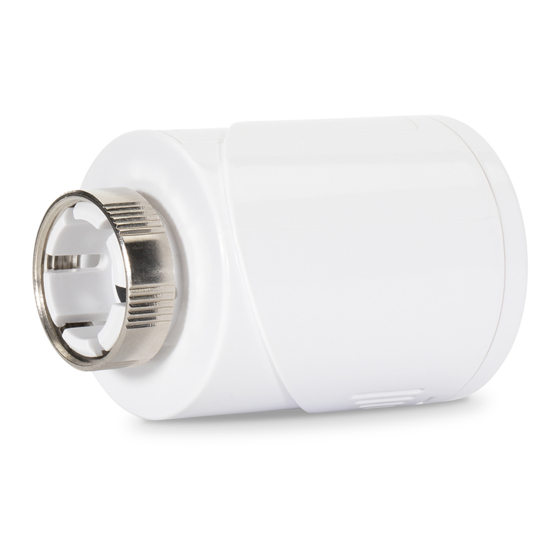
Advertisement
Quick Links
ZRT-106
Thermostatic Radiator Valve
Thermostatic Radiator Valves (TRVs) sense the air temperature around them and regulate the flow of
water through the radiator which they are fitted to.
They can be set at a level that gives you the room temperature you want. These settings may have to be
different in each room, and you can set the TRVs to suit each room and then leave them to do their job.
The device can be set temperature by manual or by gateway and schedule are created by gateway.
This product can be operated in any Z-Wave
manufacturers. All mains operated nodes within the network will act as repeaters regardless of vendor to
increase reliability of the network.
Product Overview
LCD
display
LCD Display
Time
ROOM: Current
temperature
SET: Target
temperature
HEAT Mode
Heating active
TM
network with other Z-Wave certified devices from other
Battery
cover
Valve
cap
Week
Temperature display
Key lock
ENERGY HEAT Mode
4
1
2
Button name
Function
1.
P button
For RF inclusion
2.
Power on/off
Turn on/off TRV
3.
M button
Mode select : HEAT/ ENERGY HEAT
4.
Down button
Reduce Target Temperature
5.
Up button
Increase Target Temperature
Installation
Mounting
Do not insert the batteries yet.
1.
Remove any existing control from the radiator valve
2.
Mount the TRV on the valve and tighten it by turning the Valve cap clockwise.
3.
You may need to use one of the adaptors supplied to fit your radiator valve:
5
3
Advertisement

Summary of Contents for Nexa ZRT-106
- Page 1 ZRT-106 Thermostatic Radiator Valve Thermostatic Radiator Valves (TRVs) sense the air temperature around them and regulate the flow of water through the radiator which they are fitted to. They can be set at a level that gives you the room temperature you want. These settings may have to be different in each room, and you can set the TRVs to suit each room and then leave them to do their job.
- Page 2 “ENERGY HEAT” mode: This is the lower temperature level for energy saving, typically used The TRV can be mounted at various orientation as shown below: during sleeping or when a room is empty. Setpoints for these two modes must first be preset through the gateway. The TRV will activate heating whenever room temperature falls below these setpoints.
- Page 3 COMMAND_CLASS_CONFIGURATION Z-Wave Plus Info COMMAND_CLASS_SENSOR_MULTILEVEL Role Type Node Type Installer Icon User Icon COMMAND_CLASS_APPLICATION_STATUS COMMAND_CLASS_THERMOSTAT_MODE_V3 Slave Sleeping Z-Wave Plus node Generic_Thermostat Generic_Thermostat COMMAND_CLASS_THERMOSTAT_SETPOINT_V3 Listening COMMAND_CLASS_PROTECTION COMMAND_CLASS_CLOCK Association Command Class Group Max Node Basic Command Class ...
- Page 4 3. Node ID is excluded. The device reverts to 2-second on, 2-second off factory default state. For 2 minutes Nexa Trading AB Failed or successful results in including/excluding the ID can be viewed on the Z-Wave Controller. Datavägen 37B 436 32 ASKIM - SWEDEN Note: If you are connecting this unit to a Z-Wave Controller that utilizes the S2 security protocol, you may be asked by your controller to enter a 5 digit Device Specific Key (DSK) that is unique to each unit.

Need help?
Do you have a question about the ZRT-106 and is the answer not in the manual?
Questions and answers